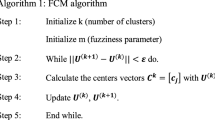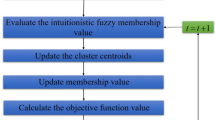Abstract
Cluster analysis is highly advantageous as it provides “relatively distinct” (or heterogeneous) clusters, each consisting of units (families) with a high degree of “natural association”. Different approaches to cluster analysis are characterized by the need to define a matrix of dissimilarity or distance between the n pairs of observations. The cluster analysis allows to identify the profiles families who meet certain descriptive characteristics, not defined a priori. Fuzzy clustering is useful to mine complex and multi-dimensional data sets, where the members have partial or fuzzy relations. Among the various developed techniques, fuzzy-C-means (FCM) algorithm is the most popular one, where a piece of data has partial membership with each of the pre-defined cluster centers. Fu and Medico [1] developed a clustering algorithm to capture dataset-specific structures at the beginning of DNA microarray analysis process, which is known as Fuzzy clustering by Local Approximation of Membership (FLAME). It worked by defining the neighborhood of each object and Identifying cluster supporting objects that have great importance in the field of market research in order to identify not only the average profiles (centroid) but the real prototypes and assigned to other units observed a degree of similarity.
The contribution is the result of joint reflections by the authors, with the following contributions attributed to S. Montrone (chapters 2), to P. Perchinunno (chapter 1 and paragraph 4.2), and to S. L’Abbate (chapter 3 and paragraph 4.1). The conclusions are the result of the common considerations of the authors.
Access this chapter
Tax calculation will be finalised at checkout
Purchases are for personal use only
Preview
Unable to display preview. Download preview PDF.
Similar content being viewed by others
References
Fu, L., Medico, E.: FLAME: a novel fuzzy clustering method for the analysis of dna microarray data. BMC Bioinformatics 8(3), (2007). doi:10.1186/1471-2105-8-3
Montrone, S., Perchinunno, P., L`Abbate, S., Zitolo, M.R.: The lifestyles of families through fuzzy C-means clustering. In: Murgante, B., Misra, S., Rocha, A.M.A., Torre, C., Rocha, J.G., Falcão, M.I., Taniar, D., Apduhan, B.O., Gervasi, O. (eds.) ICCSA 2014, Part III. LNCS, vol. 8581, pp. 122–134. Springer, Heidelberg (2014)
Fabbris, L.: Analisi esplorativa di dati multidimensionali, Cleup editore (1990)
Green, P.E., Frank, R.E., Robinson, P.J.: Cluster Analysis in text market selection. Management science (1967)
Jardine, N., Sibson, R.: Mathematical Taxonomy. Wiley, London (1971)
Chattopadhyay, S., Pratihar, D.K., De Sarkar, S.C.: A comparative study of fuzzy c-means algorithm and entropy-based fuzzy clustering algorithms. Computing and Informatics 30, 701–720 (2011)
Ma, P., Chan, K.: Incremental Fuzzy Mining of Gene Expression Data for Gene Function Prediction. IEEE Trans. on Biomedical Engineering (2010)
Zadeh, L.A.: Fuzzy sets. Information and Control 8(3), 338–353 (1965)
Dubois, D., Prade, H.: Fuzzy sets and systems. Academic Press, Boston, New York London (1980)
Cheli, B., Lemmi, A.A.: Totally fuzzy and relative approach to the multidimensional analysis of poverty. Economic Notes 24(1), 115–134 (1995)
Cerioli, A., Zani, S.: A fuzzy approach to the measurement of poverty. In: Dugum, C., Zenga, M. (eds.) Income and Wealth Distribution, Inequality and Poverty, pp. 272–284. Springer Verlag, Berlin (1980)
Author information
Authors and Affiliations
Corresponding author
Editor information
Editors and Affiliations
Rights and permissions
Copyright information
© 2015 Springer International Publishing Switzerland
About this paper
Cite this paper
Montrone, S., Perchinunno, P., L’Abbate, S. (2015). “Flame”: A Fuzzy Clustering Method to Detection Prototype in Socio- Economic Context. In: Gervasi, O., et al. Computational Science and Its Applications -- ICCSA 2015. ICCSA 2015. Lecture Notes in Computer Science(), vol 9157. Springer, Cham. https://doi.org/10.1007/978-3-319-21470-2_9
Download citation
DOI: https://doi.org/10.1007/978-3-319-21470-2_9
Published:
Publisher Name: Springer, Cham
Print ISBN: 978-3-319-21469-6
Online ISBN: 978-3-319-21470-2
eBook Packages: Computer ScienceComputer Science (R0)




